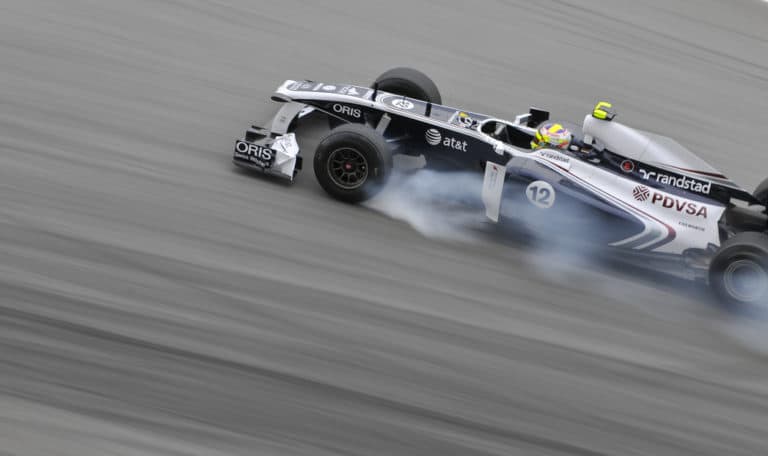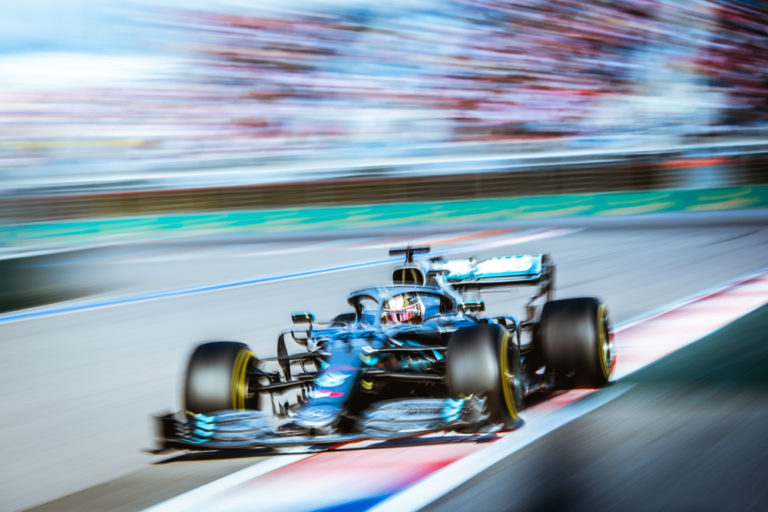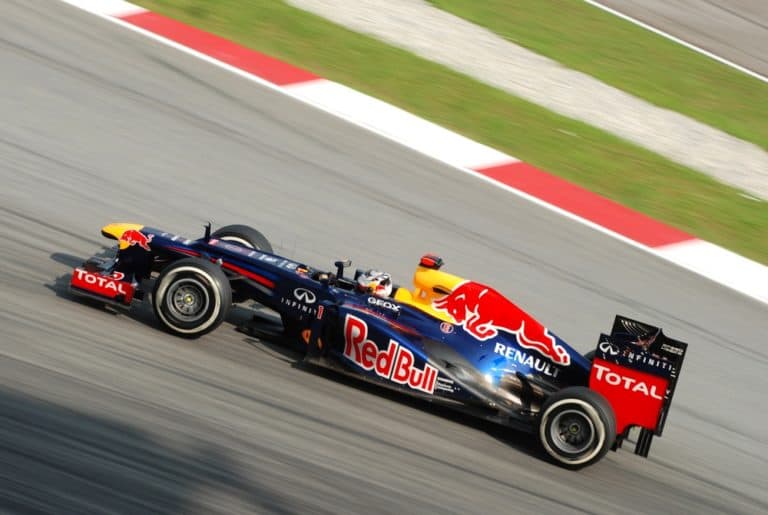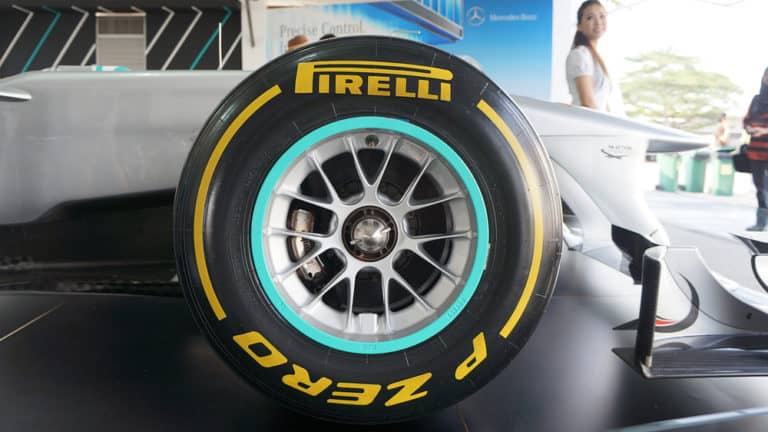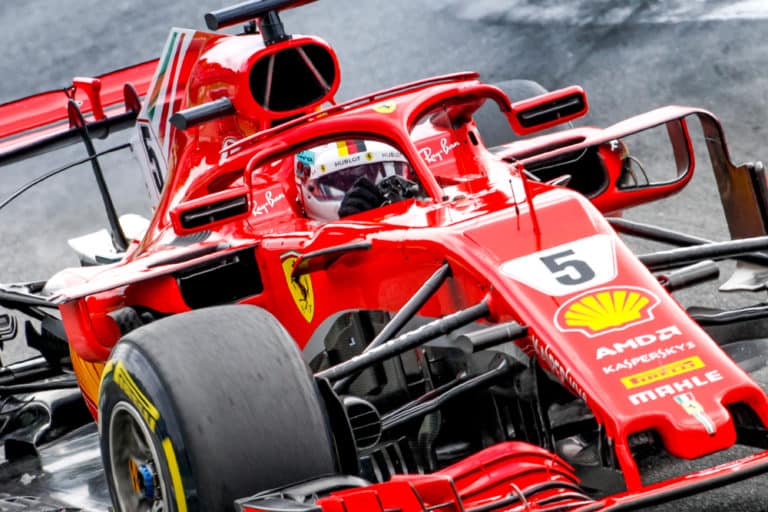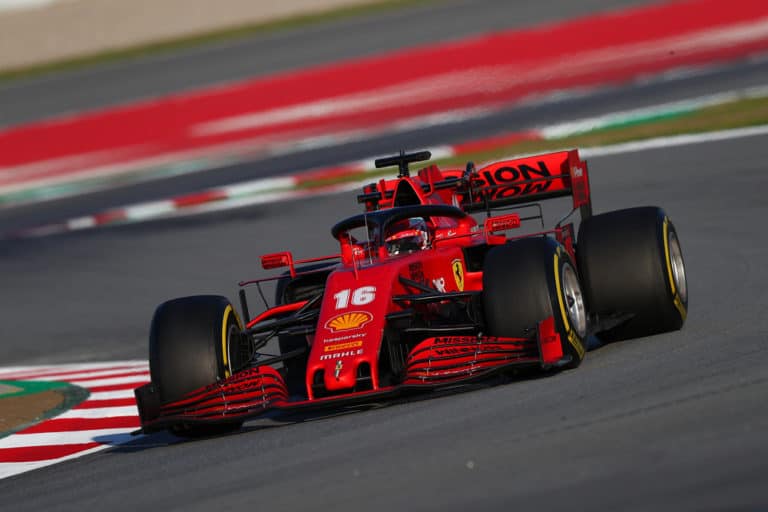Formula 1 car designers are constantly pushing the limits and finding loopholes in the technical regulations to give their cars that little bit of extra speed. Throughout the years, this has resulted in some extraordinarily innovative but often bizarre ideas. We’ll be looking at some of the inventions that yielded excellent results on track. These are the best F1 innovations.
The Best F1 Innovations Are:
- Mercedes’ Dual-Axis Steering (DAS) in 2020.
- Brawn GP’s Double Diffuser in 2009.
- McLaren’s F-Duct in 2010.
- Tyrell’s Six-Wheeled Car from 1976-78.
- Brabham’s Fan Car in 1978.
- McLaren’s Rear Brake Pedal in 1997/1998.
- Renault’s Mass-Damper in 2005.
Unfortunately, when innovations in F1 work so well, rival teams are often quick to complain. This means that out the box inventions usually only last a few races or a season at most if the teams are lucky. However, that hasn’t stopped the best F1 designers from trying new and creative solutions to gain that marginal advantage. So, read on to see these inventions and the crazy stories behind the best F1 innovations.
If you’re looking for some F1 merchandise, check out the awesome stuff at the official F1 store here.
What was Mercedes’ Dual-Axis Steering (DAS)?
Mercedes’ dual axis steering system (DAS) is the newest clever F1 innovation on this list. The team introduced it during pre-season testing ahead of the 2020 Formula 1 season, as always, with a flurry of controversy.
DAS allows the driver to push and pull on their steering wheel to change the alignment (toe) of the front wheels. If the wheel were pushed forward, the tires would be angled slightly outwards, and if the steering wheel were pulled towards the driver, the tires would be angled in.
Usually, the toe of the front wheels is fixed, and it is a compromise because different toe angles offer different things. A neutral toe (i.e., no angle inwards or outwards) is beneficial for the straights as it reduces tire scrub (the friction on the track), which means the tires will degrade more slowly, which can help increase the life of the tires. A neutral toe also produces less drag as the tires are straight and have more consistent airflow. In contrast, a toe out is better on corners as it offers more stability.
Therefore, changing the toe of the front wheels is very useful during a race, as you can vary the toe depending on the situation rather than reaching a compromise. DAS also enables the tires on the car to be heated more evenly because drivers can heat different parts of the tire, depending on how they decide to angle it.
While DAS was not the reason the team and Lewis Hamilton walked their way to both the Constructors’ and Drivers’ Championships, respectively, it did give them an added advantage, which is always helpful in F1. As a result, other teams, led by Red Bull, filed a complaint about it, which eventually saw it being banned for the 2021 Formula 1 season, with the FIA saying that the wheels can only be moved left and right, as they usually would be.
If you’re interested in learning more about the controversy surrounding DAS, it was covered in episode 2 of the recent season (season 3) of Netflix’s ‘Drive to Survive’ series.
You can watch this video to learn more about it and see how DAS works.
What was Brawn GP’s Double Diffuser?
In their only season in Formula 1, Brawn GP stormed to both the Drivers’ and Constructors’ titles, despite having a much smaller budget than their rivals. A tiny part of this success was thanks to their double diffuser installed on the back of their cars.
The 2009 Formula 1 season saw massive rule changes implemented to reduce dirty air coming off cars and promote overtaking. In the previous season, F1 cars were covered in all sorts of aerodynamic appendages designed to direct airflow. The issue with these is that they produced a lot of dirty air, which made following a car and therefore overtaking very challenging.
Therefore, the 2009 F1 season meant that Formula 1 car designers had their work cut out to improve their cars and keep them aerodynamically stable without violating the new regulations.
The benefit of the double diffuser is that it increased the height of the diffuser on the back of the car, and in doing so, increased downforce on the car. Therefore, teams with only single diffusers (such as Ferrari) had a lot less downforce on their cars. Downforce is vital in Formula 1 as it provides more grip, which means you can drive faster.
The double diffuser was met with controversy as the teams with single diffusers argued that it was against the rules. The issue was even taken to the International Court of Appeal, where a Ferrari representative said the FIA did not understand the problem. The matter was thrust into the limelight because Brawn won three of the four races at the start of the season.
In 2009, the double diffuser only gave Brawn GP a 0.3-second advantage, but the other teams, like Red Bull, thought the performance advantage was more significant. Hence, they focused a lot of time and resources on replicating it on their cars. This meant they neglected developing other vital parts of their car.
However, the efforts of Red Bull were not in vain, as it proved to be a vital component of their first championship-winning car, the RB6, driven by Sebastian Vettel in 2010. But this was the last season the double diffuser would be legal, as it was banned from the 2011 season to slow down cars.
What was McLaren F1’s F-Duct?
Before Drag Reduction System (DRS) was introduced into Formula 1 for the 2011 season, the rear wings of F1 cars were fixed, and no part of them was allowed to move. This was because F1 had banned all moveable aerodynamic components on cars.
This meant that overtaking on straights was quite challenging, as the rear wing produced a lot of drag, as it was a large, relatively flat surface that was not exceptionally streamlined. As a result, teams tried to figure out ways to reduce the drag on the rear wing, and McLaren’s F-Duct, introduced in 2010, was one such solution.
The F-Duct was a way of rerouting airflow on the long straights found on many Formula 1 circuits worldwide. It was a snorkel-type thing placed on the car’s front wing that had a pipe traveling to the rear wing and another pipe coming out the back of the engine. There was also an outlet in the cockpit of the car.
The way it worked was that the driver could cover the outlet in the car’s cockpit with their left leg, which they didn’t need on long straights. This would divert the airflow to a fluidic switch just above the driver’s head in the airbox. From here, the air would be diverted onto the rear wing, which interrupted the airflow on the wing’s surface. This resulted in less drag being produced which meant the cars could go up to 6 miles faster on the straights.
The F-Duct was not against the rules, as it was not a moveable aerodynamic device. This was because drivers operated it using their knees, so they moved, rather than a piece of a car.
However, despite many other teams adopting a version of it, it would be banned for the 2011 season. Some teams required drivers to use their hands to close the inlet in the cockpit, which was dangerous as they would only have one hand on the steering wheel. Often, the other hand would be required to change the brake balance on the car, which meant drivers did not have any hands available to steer the car.
Furthermore, Drag Reduction System (DRS), which is still in use in 2021, was introduced the following season to improve overtaking by reducing drag caused by the rear wing on the straights. DRS was a much more consistent way of reducing drag as it was constant across all teams. It was also safer than the F-Duct, as it did not require drivers to remove their hands from the steering wheel while driving at high speeds.
What was Tyrell’s Six-Wheeled F1 Car?
If you thought that Formula 1 cars have always only had four wheels, then you’d be wrong. In the 1976 F1 season, British team Tyrell introduced a six-wheeled Formula 1 car. The idea was to produce something very different, as all the teams (bar Ferrari) were using the same engine, gearbox, and tires, so the playing field was relatively level.
While outlandish, it was a relative success for a short while, and other F1 teams even copied the idea. However, in its second season, it wasn’t nearly as successful, and it was later scrapped for the 1978 season, and F1 rules later stipulated that all cars could only have four wheels (nothing more, or less).
Tyrell’s six-wheeler was very different from other F1 cars (not including the fact that it had two more wheels). The way it worked was that it had two wheels at the back, positioned just in front of the rear wing, and four wheels in the front.
The four front wheels were much smaller than the rear ones (they had to be specially made by Goodyear). The cars even featured portholes that allowed the drivers to see their front wheels, as the car’s cockpit sat above the front tires, which were in line with the bodywork, unlike what we see in modern F1 cars.
The car was quite successful as containing the front tires within the bodywork width reduced the amount of lift they generated. This allowed the designer to simplify the front aerodynamics, as there was less effort needed to keep the car stable on the track.
While it was initially successful, with Jody Scheckter putting the car on pole at the Swedish Grand Prix before leading the team home for a famous one-two at the end of the race. It also featured on the podium several times in its two years, with Patrick Depallier claiming eight podiums in the infamous six-wheeled car over two years.
However, the car quickly began to fall behind its competitors. The brake balance was a massive struggle, as the drivers had to deal with six rather than four wheels, which made braking while turning a challenge. Another problem was that Goodyear didn’t spend any time developing the tiny front tires of the car.
Therefore, while the other F1 teams reaped the benefits of new and improved Goodyear tires, Tyrell was stuck with those of the same quality as the tires they started the project with. This meant that they were essentially left behind in this regard.
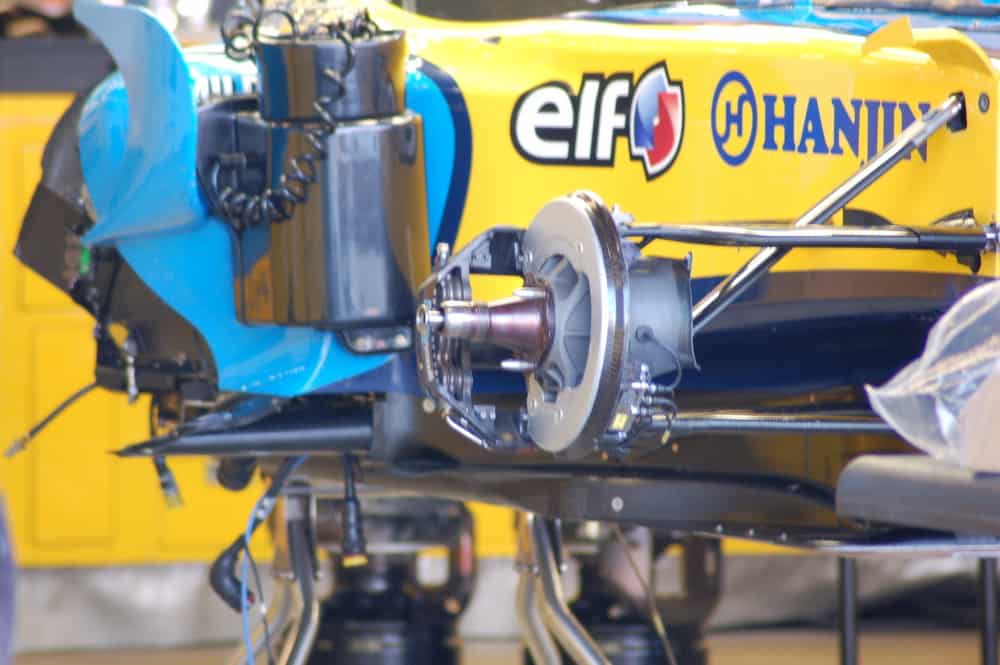
What was Brabham’s ‘Fan’ Car?
In 1978, the Lotus F1 team revolutionized Formula 1 when they invented the ground effect. Aerodynamic effects and designs create favorable downforce on the car by essentially sucking it to the track. Downforce = more grip = better speed = a more competitive racing car.
Therefore, other teams had to keep up with them, and the fan car was just one of the attempts to do so. The rule book stated that moveable devices used to give an aerodynamic advantage are not allowed in F1. However, the fan at the car’s back circumvented these regulations as it was primarily used to cool the engine.
But a side effect of the fan was that it sucked the car to the track and produced more downforce. It was so successful because the entire area surrounding the cockpit and engine was essentially sealed to the ground, which meant that the fan was the only outlet for the air in that area. It gave the car a significant performance advantage on high-speed straights and low-speed corners.
In the only race it competed in, the 1978 Swedish Grand Prix at Anderstorp, Niki Lauda won the race. However, the other teams complained so much that Brabham withdrew the design after that race despite it being deemed legal.
The reason for this is that Brabham team owner Bernie Ecclestone had just become the Chief Executive of the Formula One Constructor’s Association, known as FOCA, in 1978 (the same year the fan car was introduced). The other team owners on the association put a lot of pressure on Ecclestone to withdraw the car. He did because he was worried that the other teams would withdraw from the association and collapse it if he refused.
Gordon Murray, who designed the infamous fan car, would later claim that it was a wholly political decision by Ecclestone as he wanted to establish himself in FOCA. Murray said that Ecclestone was working on launching himself towards doing “what he is doing now.” At the time of the statement, Bernie Ecclestone was the chief executive of the Formula 1 group. This was a position he held from 1987 until 2017.
This concise documentary, made by the BBC, details the controversy behind the fan car.
What was McLaren F1’s Rear Brake Pedal?
As we have seen, McLaren is no stranger to innovative solutions to gain an advantage on the track. One of their more famous inventions was an extra pedal, designed to control the rear brakes of their Formula 1 cars towards the end of the 1997 season and the start of the 1998 season.
Typically, F1 cars have only two pedals; the brake and the accelerator, with the clutch being a paddle on the steering wheel. However, in these McLaren cars, they installed an extra brake, which would be used to control the brake on of the rear wheels. They would decide before the race, depending on the characteristics of the circuit, which side they wanted to control.
The benefit of controlling the rear brake was that it reduced understeer around corners because the outside wheel also applied brake pressure. This made the car more stable and much easier to take corners with, as the car naturally turned into the corner, which meant the drivers didn’t have to lock their steering as much as they previously had to to make the corner.
While McLaren initially managed to keep their clever invention a secret from the rest of the paddock, an eagle-eyed photographer Darren Heath spotted something unusual in his photos after the Austrian Grand Prix. He realized that one of the rear brake discs on both McLaren cars was glowing as they were accelerating out of the corner. This was highly unusual, as braking in the corner was associated with slowing down, not speeding up.
So, Heath and his editor Matt Bishop became determined to determine why the rear brakes were glowing. Heath finally had his opportunity during the 1997 Luxembourg Grand Prix when both McLarens retired. He managed to locate Mika Hakkinen’s car and snap a few photos of the foot-well. After getting them developed, they clearly showed an extra pedal in the car, and the secret was finally out.
The rest of the paddock was furious and claimed that it was illegal. However, they didn’t understand how it worked, with many rivals coming up with bizarre explanations. Many other teams thought it would cost millions to install in their cars, so they wanted it banned.
Unfortunately for McLaren, it was banned after a few races in the 1998 season because it was a four-wheel steering system, as in the 1998 season, the drivers could choose during the race which wheel they wanted brake pressure to be applied to.
McLaren team principal Ron Dennis criticized the other teams for getting it banned, as he said they didn’t want to “rise to the technical challenge.” Despite the ban, McLaren won the Constructors’ Championship that season, and Mika Hakkinen would win the 1998 and 1999 World Drivers’ Titles.
The story of the search for McLaren’s ingenious rear brake pedal was covered in-depth in an episode of the ‘F1 On The Edge’ Podcast.
Here is the Spotify link, but you can access it on all major podcast platforms.
What was Renault F1’s Mass-Damper?
Fernando Alonso and Renault dominated Formula 1 in 2005 and 2006, with Alonso winning both World Championship’s and Renault winning both Constructors’ Titles. These championship wins brought Michael Schumacher and Ferrari’s period of supremacy to an end.
Part of Renault’s success in these two years was the mass damper they installed in the front nose cone of their Formula 1 cars towards the end of the 2005 F1 season. It was a relatively simple device consisting of a weight with two springs on either end. This was situated in a cylinder placed in the nose cone. The weight could also be replaced, which meant it could be adapted to suit the needs of a particular racing track.
The reason for its implementation is that in 2005, the front wing of a Formula 1 car had to be 50mm higher than the previous season, which reduced downforce. As a result, teams lowered the suspension of the whole car to get it closer to the ground and improve downforce. The issue with this is that it requires very stiff springs on the car to prevent it from running too low and ‘bottoming out.’ These hard springs meant that the front wing bore the brunt of the impact with the track and caused it to bounce up and down. This disturbed the airflow over the front wing and the entire car, which reduced downforce.
The mass damper improved the stability of the front wing, as it helped keep it stable by counteracting the up and down movement of the wing. This was very helpful when the car went over curbs, which caused the front wing to bounce up and down a lot. Essentially, the mass damper counteracted the new regulation changes.
The mass damper added at least a second to the speed of the Renault as it improved the stability of the car around corners and made the drivers a lot more confident in their cars. While it was an extra weight added to the car, the performance benefits it gave were more than worth it. The mass damper also worked well with Michelin, who produced the tires for the Renault F1 cars, as the rubber they used was more effective with the device.
Renault wasn’t the only team to run it, though, as the rest of the teams on the Formula 1 grid realized how useful it was and attempted to install their own versions. However, towards the end of the 2006 F1 season, the mass damper was banned as it was said to be a moveable aerodynamic device (which is not allowed on Formula 1 cars), and that was the end of that.
Conclusion
Throughout the years, Formula 1 car designers have developed ingenious solutions to gain an advantage over their rivals on the F1 track. Sometimes these are tiny, simple inventions, while other times, they’re bizarre. However, due to the success of the innovations on this list, they were all subsequently banned, or withdrawn, after the rest of the teams on the paddock complained.
References
- https://drivetribe.com/p/mercedes-das-system-ban-is-more-BcqwNN4VRQuGrRHwtUBolQ?iid=XozQ9w2eQwCAZwnJVpAaZQ
- https://www.formula1.com/en/latest/article.das-explained-what-we-know-so-far-about-mercedes-trick-new-steering-system.4vgDQ6cc20xUfhdZGT0ejB.html
- https://www.formula1.com/en/latest/features/2016/6/six-fascinating-facts-tyrrell-P34.html
- https://www.youtube.com/watch?v=rnIjQC08qKk&t=11s&ab_channel=FORMULA1
- https://en.wikipedia.org/wiki/Tyrrell_P34
- https://drivetribe.com/p/the-double-diffuser-one-of-the-EVucYcTWRo2eEa9cw4CrvA?iid=QU8928q1T9KX8uezJ60BKg
- https://africa.espn.com/f1/story/_/id/28167450/busting-myth-brawn-gp-legendary-double-diffuser
- https://www.motorsport.com/f1/news/banned-tech-brabham-bt46b-fan/4808234/
- https://en.wikipedia.org/wiki/Brabham_BT46
- https://www.autosport.com/f1/news/banned-f1-tech-renaults-confidence-inducing-damper-solution-4982787/4982787/
- https://www.formula1.com/en/results.html/2006/team.html
- https://www.autosport.com/f1/news/banned-the-2010-formula-1-seasons-f-duct-4983082/4983082/
- https://www.mclaren.com/racing/inside-the-mtc/mclaren-extra-pedal-3153421/
- https://www.autosport.com/f1/news/banned-the-2010-formula-1-seasons-f-duct-4983082/4983082/

